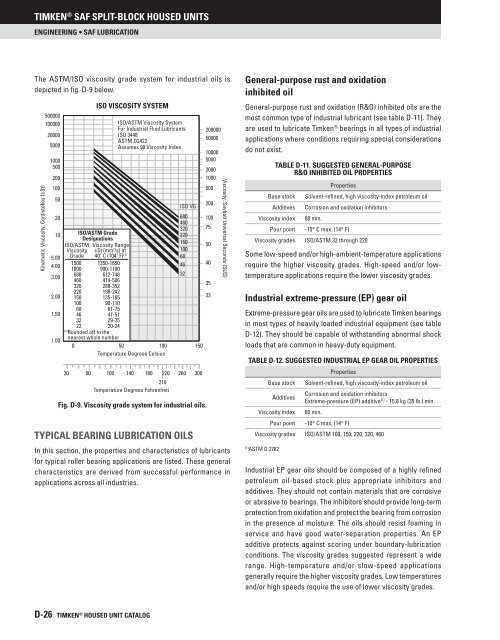Create successful ePaper yourself
Turn your PDF publications into a flip-book with our unique Google optimized e-Paper software.
<strong>Timken</strong> ® SAF SPLIT-BLOCK HOUSED UNITS<br />
Engineering • SAF Lubrication<br />
The ASTM/ISO viscosity grade system for industrial oils is<br />
depicted in fig. D-9 below.<br />
Kinematic Viscosity, Centistokes (cSt)<br />
500000<br />
100000<br />
20000<br />
5000<br />
1000<br />
500<br />
200<br />
100<br />
50<br />
20<br />
10<br />
5.00<br />
4.00<br />
3.00<br />
2.00<br />
1.50<br />
1.00<br />
ISO/ASTM Grade<br />
Designations<br />
ISO/ASTM Viscosity Range<br />
Viscosity cSt (mm 2 /s) at<br />
Grade 40˚ C (104˚ F) (1)<br />
1500 1350-1650<br />
1000 900-1100<br />
680 612-748<br />
460 414-506<br />
320 288-352<br />
220 198-242<br />
150 135-165<br />
100 90-110<br />
68 61-75<br />
46 41-51<br />
32 29-35<br />
22 20-24<br />
(1)<br />
Rounded off to the<br />
nearest whole number<br />
ISO viscosity system<br />
ISO/ASTM Viscosity System<br />
For Industrial Fluid Lubricants<br />
ISO 3448<br />
ASTM D2422<br />
Assumes 90 Viscosity Index<br />
ISO VG<br />
680<br />
460<br />
320<br />
220<br />
150<br />
100<br />
68<br />
46<br />
32<br />
0 50 100 150<br />
Temperature Degrees Celsius<br />
20 60 100 140 180 220 260 300<br />
210<br />
Temperature Degrees Fahrenheit<br />
Fig. D-9. Viscosity grade system for industrial oils.<br />
typical bearing lubrication oils<br />
200000<br />
50000<br />
10000<br />
5000<br />
2000<br />
1000<br />
500<br />
In this section, the properties and characteristics of lubricants<br />
for typical roller bearing applications are listed. These general<br />
characteristics are derived from successful performance in<br />
applications across all industries.<br />
200<br />
100<br />
75<br />
50<br />
40<br />
35<br />
33<br />
Viscosity, Saybolt Universal Seconds (SUS)<br />
General-purpose rust and oxidation<br />
inhibited oil<br />
General-purpose rust and oxidation (R&O) inhibited oils are the<br />
most common type of industrial lubricant (see table D-11). They<br />
are used to lubricate <strong>Timken</strong> ® bearings in all types of industrial<br />
applications where conditions requiring special considerations<br />
do not exist.<br />
TABLE D-11. Suggested general-purpose<br />
R&O INHIBITED oil properties<br />
Properties<br />
Base stock Solvent-refined, high viscosity-index petroleum oil<br />
Additives Corrosion and oxidation inhibitors<br />
Viscosity index 80 min.<br />
Pour point -10° C max. (14° F)<br />
Viscosity grades ISO/ASTM 32 through 220<br />
Some low-speed and/or high-ambient-temperature applications<br />
require the higher viscosity grades. High-speed and/or lowtemperature<br />
applications require the lower viscosity grades.<br />
Industrial extreme-pressure (EP) gear oil<br />
Extreme-pressure gear oils are used to lubricate <strong>Timken</strong> bearings<br />
in most types of heavily loaded industrial equipment (see table<br />
D-12). They should be capable of withstanding abnormal shock<br />
loads that are common in heavy-duty equipment.<br />
TABLE D-12. SUGGESTED INDUSTRIAL EP GEAR OIL PROPERTIES<br />
Properties<br />
Base stock Solvent-refined, high viscosity-index petroleum oil<br />
Additives<br />
Corrosion and oxidation inhibitors<br />
Extreme-pressure (EP) additive (1) - 15.8 kg (35 lb.) min.<br />
Viscosity index 80 min.<br />
Pour point -10° C max. (14° F)<br />
Viscosity grades ISO/ASTM 100, 150, 220, 320, 460<br />
(1)<br />
ASTM D 2782<br />
Industrial EP gear oils should be composed of a highly refined<br />
petroleum oil-based stock plus appropriate inhibitors and<br />
additives. They should not contain materials that are corrosive<br />
or abrasive to bearings. The inhibitors should provide long-term<br />
protection from oxidation and protect the bearing from corrosion<br />
in the presence of moisture. The oils should resist foaming in<br />
service and have good water-separation properties. An EP<br />
additive protects against scoring under boundary-lubrication<br />
conditions. The viscosity grades suggested represent a wide<br />
range. High-temperature and/or slow-speed applications<br />
generally require the higher viscosity grades. Low temperatures<br />
and/or high speeds require the use of lower viscosity grades.<br />
D-26 TIMKEN ® HOUSED UNIT CATALOG

















